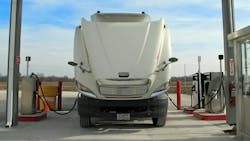Five steps to manage fleet fuel efficiency goals
Fleets already know how much fuel impacts their bottom line and environmental footprint, and they likely have targets for how much fuel they should use based on mileage and/or engine hours. But those fuel efficiency goals have to be achievable and measurable so fleets can adapt strategies as needed, leading to continuous improvement and long-term benefits for your company and the environment.
Here's how to get started:
1. Assess current fuel efficiency
Understanding your fleet’s fuel efficiency metrics is essential to help you better manage fuel costs and identify areas for improvement.
To collect and analyze fuel consumption data effectively, consider using telematics and GPS tracking to monitor real-time fuel usage, alongside reviewing fuel purchase records and maintenance logs. These methods provide a comprehensive view of your fleet’s performance and enable you to set informed, realistic goals and make data-driven decisions to optimize fuel efficiency.
2. Set informed, realistic fuel efficiency goals
To establish baseline metrics from your current data, analyze your fleet’s average fuel consumption and identify trends or patterns over time. When setting fuel efficiency goals, consider these trends and factors like vehicle type and age, driving conditions, routes, and driver behavior. These factors help set realistic and achievable short and long-term goals that lead to continuous improvement and significant cost savings.
For example, a short-term goal might be reducing fuel consumption by 5% over the next six months by implementing regular maintenance and driver training programs. Meanwhile, long-term goals include transitioning a portion of your fleet to hybrid or electric vehicles within five years to achieve a 20% reduction in overall fuel costs.
Read more: How fleets can reduce their carbon footprint without EVs
3. Implement strategies to meet your goals
Regular service and preventive maintenance maintain fuel efficiency and prevent catastrophic failures. Ensuring your vehicles receive timely oil changes, filter replacements, and engine tune-ups helps them run more efficiently, helping your fleet reach their fuel goals.
Additionally, tire pressure monitoring and alignment checks are essential practices. Properly inflated and aligned tires improve fuel economy and enhance safety by providing better handling and reducing the likelihood of tire-related accidents.
Finally, adopting eco-driving techniques can further boost fuel efficiency and safety. As Guy Broderick from Kriska Holdings points out, avoiding harsh braking, not following too closely, and making smooth turns can improve fleet-wide safety and fuel economy. Moreover, implementing driver coaching and incentive programs for fuel-efficient driving encourages drivers to adopt these best practices. Rewarding drivers who consistently achieve high fuel efficiency and safety standards motivates the team to prioritize these behaviors.
4. Monitor and adjust goals
Continuous monitoring and data analysis maintains and improves fuel efficiency in fleet operations. Fleet management technology offers fuel reports that provide detailed insights into your vehicle’s fuel usage, helping you identify patterns and areas for improvement. Utilizing tools and software for real-time fuel efficiency tracking also allows you to make immediate adjustments and optimize performance.
Regularly reviewing these data trends allows you to adjust your goals to reflect current conditions and achieve better results. Whether identifying underperforming vehicles or adapting to changing fuel prices, this proactive approach ensures your fleet continues to work toward its goals in a sustainable manner.
5. Commit to ongoing improvement and adaptability
Continuous improvement and adaptation based on current data are crucial to fuel efficiency in fleet operations. Make sure you have systems in place to follow up on your goals and monitor your strategies, so that you know when you need to pivot. Embracing these practices will lead to long-term cost savings, enhanced safety, and a reduced environmental impact, ensuring your fleet stays competitive and sustainable.
About the Author

Evelyn Long
Evelyn Long is a fleet writer with several years of experience in the field. She writes for sites like Commercial Truck Trader and shares advice on her blog, Renovated Magazine. Evelyn is passionate about helping fleet managers and drivers operate optimized fleets for greater efficiency at less cost.
